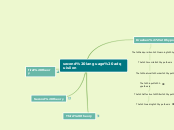second language adquisiion
Krashen's hypothesis
The adquisition- learning hypothesiss
According to Krashen, there are two ways of developing language ability. Acquisition involves the subconscious acceptance of knowledge where information is stored in the brain through the use of communication; this is the process used for developing native languages.
The monitor hypothesis
This hypothesis further explains how acquisition and learning are used; the acquisition system, initiates an utterance and the learning system ‘monitors’ the utterance to inspect and correct errors.
The natural order hypothesis
According to Krashen, learners acquire parts of language in a predictable order. For any given language, certain grammatical structures are acquired early while others are acquired later in the process. This hypothesis suggests that this natural order of acquisition occurs independently of deliberate teaching and therefore teachers cannot change the order of a grammatical teaching sequence.
The input hypothesis
This hypothesis suggests that language acquisition occurs when learners receive messages that they can understand, a concept also known as comprehensible input. However, Krashen also suggests that this comprehensible input should be one step beyond the learner’s current language ability, represented as i + 1, in order to allow learners to continue to progress with their language development.
The affective filter hypothesis
According to Krashen one obstacle that manifests itself during language acquisition is the affective filter; that is a 'screen' that is influenced by emotional variables that can prevent learning. This hypothetical filter does not impact acquisition directly but rather prevents input from reaching the language acquisition part of the brain.
The reading hypothesis
This hypothesis basically states that the more we read in a SL the greater our vocabulary will be.It is important to involve reading in the language classroom to increase knowledge of the language and the way it is used in real-life contexts.
first theory
The first theory you need to know is the Silent Period, developed by Stephen Krashen. The silent period is a learner designated time. This can be just a few short weeks, or can last up to nine months, during which the student is silent.
Second theory
The second important theory is input hypothesis, also developed by Stephen Krashen. This is the idea that students progress when they are provided with language at their level and at a slightly more advanced level.
Third theory
The final theory is called Content Language Integrated Learning, referred to as CLIL. This was developed by David Marsh. This is more of a methodology that supports language being learned through content.
